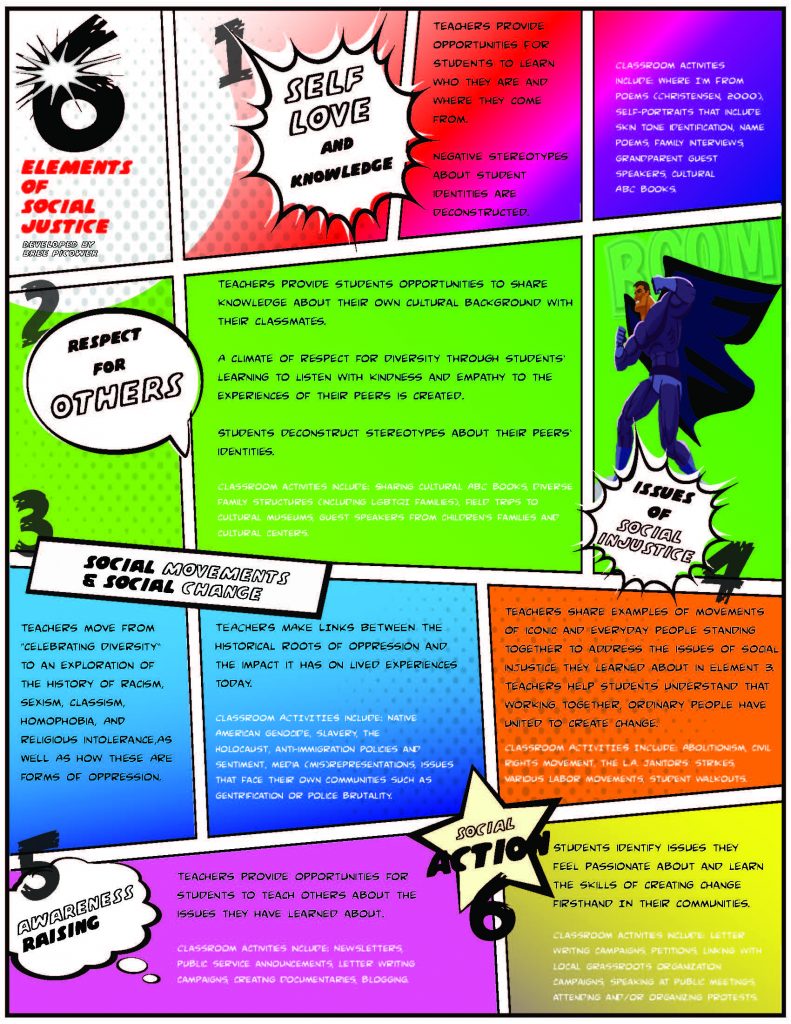For more information about the Six Elements, see this article:
Thank you Sheryl Davis at San Francisco Human Rights Commission for creating this graphic!
|
Six Elements of Social Justice Curriculum Design for Elementary Education |
| 1) Self-love and knowledge: Teachers provide opportunities for students to learn about who they are and where they come from. A sense of dignity in their culture, heritage, ethnicity/race, religion, skin tone, gender etc. is cultivated in the classroom. Students learn about different aspects of their identity and history associated with it. Negative stereotypes about students’ identities are deconstructed. Potential classroom activities include: Where I come from poems, self-portraits that include skin tone identification, name poems, family interviews, grandparent guest speakers, cultural abc books. |
| 2) Respect for Others: Teachers provide opportunities for students to share their knowledge about their own cultural background with their classmates. The goal is to create a climate of respect for diversity through students learning to listen with kindness and empathy to the experiences of their peers. Students deconstruct stereotypes about their peers’ identities. Potential classroom activities include: Sharing of cultural ABC books, diverse family structures that include LGTB families, field trips to cultural museums, guest speakers from children’s families and cultural centers. |
| 3) Issues of Social Injustice: Teachers move from “celebrating diversity” to an exploration of how diversity has differently impacted various groups of people. Students learn about the history of racism, sexism, classism, homophobia, religious intolerance etc. and how these forms of oppression have affected different communities. Teachers make links that show how the historical roots of oppression impact the lived experiences and material conditions of people today. Potential topics of study include: Native American genocide, Slavery, the Holocaust, anti-immigration policies and sentiment, media (mis) representations, issues that face their own communities such as gentrification, police brutality, etc. |
| 4) Social Movements and Social Change: Teachers share examples of movements of iconic and everyday people standing together to address the issues of social injustice they learned about in Element Three. Rather than leaving students feeling overwhelmed and defeated, teachers help students understand that working together, ordinary people have united to create change. Potential topics of study include: Abolitionism, civil rights movement, the L.A. janitors’ strikes, various labor movements, 1968 and 2006 Chicano student walkouts. |
| 5) Awareness Raising: Teachers provide opportunities for students to teach others about the issues they have learned about. This allows students who feel passionately about particular issues to become advocates by raising awareness of other students, teachers, family and community members. It is important to recognize that while raising awareness is a necessary and important pre-curser for action, it by and of itself does not translate into change. Potential activities include: newsletters, public service announcements, letter writing campaigns, creating documentaries, blogging. |
| 6) Social Action Teachers provide opportunities to take action on issues that affect students and their communities. Students identify issues they feel passionate about and learn the skills of creating change firsthand. Potential activities include: Letter writing campaigns, petitions, linking with local grassroots organization campaigns, speaking at public meetings, attending and/or organizing protests. |

